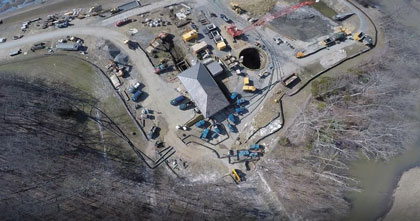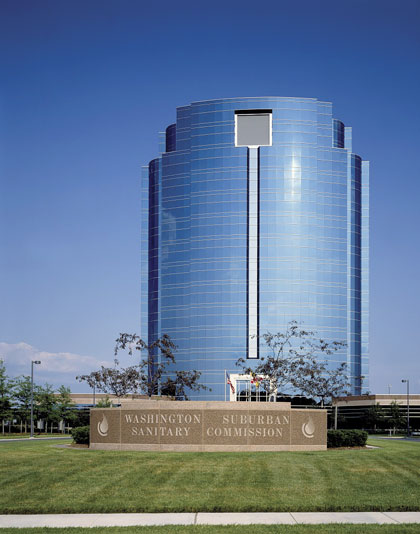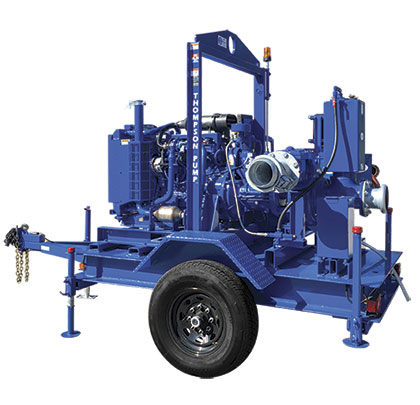What began as an otherwise nondescript Thursday afternoon in mid-February of this year in a municipality near Washington D.C. ended with an unexpected catastrophe area officials were not prepared to handle alone. A 20-inch cast iron pressurized sewer main ruptured at a Maryland wastewater treatment plant.
The Washington Suburban Sanitary Commission (WSSC) and Maryland Department of Environment (MDE) were called in, as were emergency maintenance crews employed by the wastewater treatment plant, and Ross Contracting, Incorporated. Everyone quickly came to the consensus that this was a much larger issue than they could fix by themselves; this was going to be a serious multi-day repair requiring outside help and some heavy machinery. Enter Florida-based Thompson Pump, manufacturer of top-quality pumps and related equipment that also provides engineering expertise for construction dewatering, bypass, and emergency operations.
When Thompson’s pump engineers arrived there was no equipment onsite, but once they were advised of the situation they knew they had to react and get control of the situation. With the municipality and Ross’s team’s help, Thompson determined the flow of the treatment plant was 12 million gallons per day based on the existing conditions.
Thompson’s crew mobilized four 8-inch dry prime pumps with the Enviroprime System® and 1,200 lineal feet of 8-inch Quick Connect Pipe that allowed them to route the wastewater into a nearby overflow/retention lagoon. Everything was installed by 11:00 that evening and the immediate issues were under control.
This was a major victory by anyone’s standards, but the solution was only temporary.
That’s because the wastewater continued flowing and within a day, the retention/overflow lagoon was already close to maximum capacity. The Thompson team deployed five additional Thompson 6-inch dry priming pumps with the Enviroprime System® to pump the contents of the first overflow lagoon into a second one, increasing the holding capacity of the sewer.

While this was another milestone achieved, it was also another short-term solution. Before anything could even be repaired, the existing sewer lines needed to be inspected to allow the team to understand the extent of damage that occurred in the line. The engineers, along with the team of city employees and the contractor, concluded that the construction of a 30 million gallons per day pump-a-round was needed to allow for the inspection and repair of the existing sewer line.
Brown and his team met with all involved and the decision was made to begin the construction of the bypass immediately. Pumps and pipe would need to be installed, thereby diverting the sewage flow from the influent pump station to the grit facility.
The next morning, the massive multi-day undertaking began. Six Thompson 12-inch dry prime pumps with the Enviroprime System® and three discharge lines (each measuring 2,000 lineal feet) were mobilized. A forklift, two Bobcats, and two fusion machines were brought in. Light towers were set up to ensure the safety of the workers, who were routinely working deep into the night.
The entire system took six long days to set up and the bypass began. As much as one would have liked to have done it more quickly, the pipe fusion process takes time, which creates an exceptionally durable bond (making them much less susceptible to leaking). In this line of work, particularly in a job as big and complex as this, it is vital that everything works as it is supposed to. Thompson engineers also had to make sure they were always in compliance with the government’s guidelines, eliminating spills or sewage leakage and ensuring that the team was working safely.

All three of Thompson’s discharge lines/pipes were installed above ground. This part of the process was completely trenchless allowing the team to complete the project in a shorter time frame. From beginning to end, the Thompson Pump and Ross crew operated the pumps around the clock, monitored the system and fueled the equipment being used to perform the bypass. The project lasted about thirty days without disruption.
Pump technicians were charged with conducting hourly checks, allowing them to promptly spot any irregularities; and quickly and efficiently fix mechanical issues and release the occasional clog. In addition to installing the sixteen dry prime Enviroprime System® pumps with Silent Knight® sound enclosures used to pump the sewage and the 8,000 lineal feet of pipe and hose, It took thousands of man hours to install, operate, and tear down the project.
The Ross team was pivotal in the success of this project. Thompson worked side by side from the first phone call to the completion of the job, and the effectiveness of the project was due to both teams being able to function as one.
Playing an instrumental part in fixing large-scale problems like this is what motivates the team from Thompson Pumps. It is such a fantastic feeling when everyone sees how grateful they are to the team for solving what was a very serious problem—and hearing about how they couldn’t believe how well the trenchless bypass worked. The municipality and contractors very much appreciated Thompson’s fast response time and the fact that they stayed and ensured that there were no interruptions in the products’ operation throughout the entire process.” ◆
Howard Brown is sales manager of Thompson Pump’s Baltimore/Washington D.C. branch. Thompson Pump is respected worldwide for its sophisticated heavy-duty lines of high quality, high performance dewatering and construction pumps, ranging in size from 2 to 18 inches. Thompson Pump sells and rents their entire line of pumps in the areas of public works, construction, agriculture, dewatering, mining, sewer/lift stations, and water/wastewater. For more information, visit www.thompsonpump.com.
____________________________________________
MODERN PUMPING TODAY, August 2017
Did you enjoy this article?
Subscribe to the FREE Digital Edition of Modern Pumping Today Magazine!
![]()


